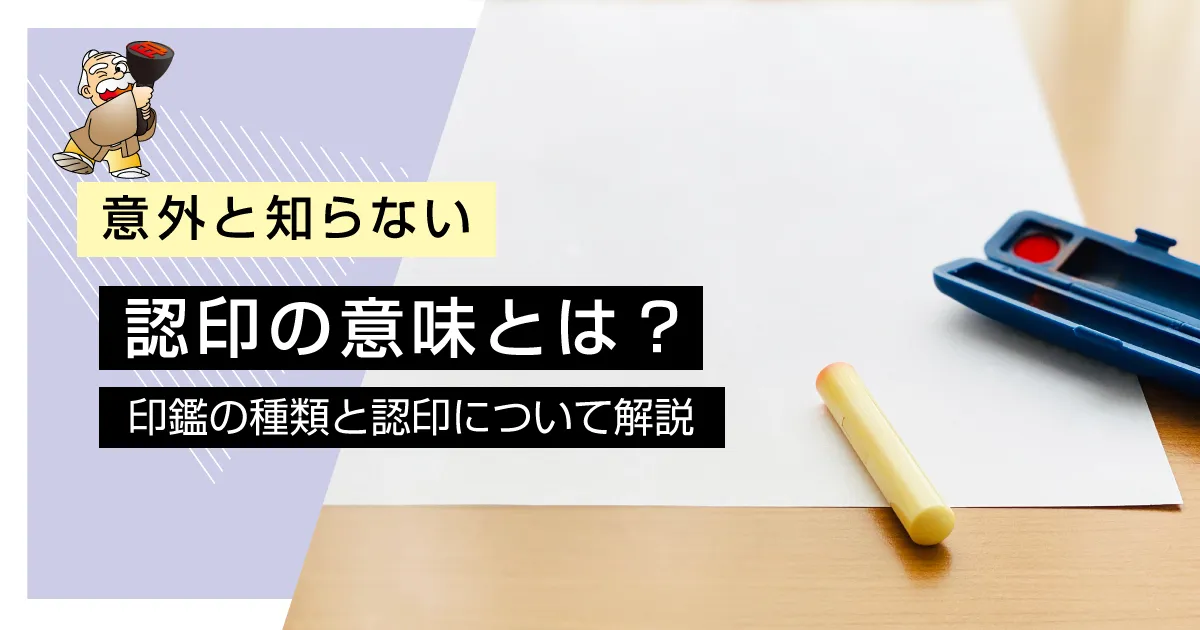A stamp that is stamped to signify approval or confirmation when receiving mail or checking documents is called a ``notification seal.'' A personal seal is the most commonly used HANKO in daily life, but do you know the difference between it and other HANKO such as a registered seal and a bank seal? We will explain the meaning and usage of ``Mitsui'', which many people don't know about.
What is a registered seal?
A registered seal is a HANKO that has not been registered with the city, ward, town, or village. Both ``mitomein'' and ``ninin'' are correct ways to read the seal, but it is common to read it as ``mitomein.'' A seal is a stamp that indicates "approval/confirmation" and is mainly used when receiving mail or when applying for documents at a municipal office.
There are three types of HANKO we hold: registered seals, bank seals, and registered seals.
As long as it is clear that the seal was affixed with the HANKO, there is no problem using a registered seal or a bank seal as the seal. However, it is dangerous to use important HANKO registered with government offices or financial institutions, such as registered seals or bank seals, as identification seals that are easily seen by the public, as there is a high risk that they will be forged. It is recommended that you prepare a separate HANKO specifically for that purpose.
[Scenes when using a registered seal]
- Birth registration
- Marriage registration/divorce notification
- Notification of moving in/notifying of moving out
- Request for a copy of family register
- Application for resident card
- National health insurance procedures
- National pension procedures
- Contract to be submitted to the company
- Receiving a courier
- mail forwarding etc.
Definition and regulations of seal
There are no legal rules regarding seals, and there are no specific rules regarding what kind of HANKO should be used. Therefore, even if the HANKO has a picture on it or the edge of the seal is missing, the HANKO held by the person can be used as a registered seal.
You can also have multiple seals, so it is convenient to have several for each location, such as at home and at work.
Difference between registered seal and bank seal
In addition to the HANKO, there are other types of seals: registered seals and bank seals. Let's take a look at the difference between the seal and the seal.
A registered seal is a HANKO HANKO .
A registered seal is a HANKO that has been registered at a municipal office. By registering HANKO, a "HANKO Registration Certificate" will be issued, which will have legal effect as a registered seal. While a registered HANKO is used to approve simple contracts, a registered seal is used for important transactions involving large sums of money. Unlike a registered seal, you cannot have multiple copies, and as a general rule, each person can only register one registered seal. Also, if the face of the seal is chipped and the shape of the seal changes from when it was registered, it will not be possible to verify it as a registered seal, so please make a new registered seal and complete the procedures for resealing.
The bank seal is the HANKO registered to the bank.
A bank seal is a HANKO that you register with the bank when opening an account at a financial institution such as a bank. Only after registration will it become effective as a bank seal. It is pressed when making a transaction at a bank counter or issuing a check, so be careful when handling it. Similar to registered seals, HANKO with missing seals cannot be verified, so please complete the procedures for resealing with a new HANKO.
Difference between HANKO using ink and penetrating stamps with built-in ink
Have you ever seen a message that says ``Shachihata not allowed'' when you are asked to affix a seal? Shachihata is one of the penetrating ink stamps made by Shachihata Co., Ltd. that can be stamped like a stamp. Shachihata can also be used as a seal, but it may not be used on official documents.
There are two main types of seals:
There are two types of seals: HANKO that are stamped with vermilion ink, and stamps with built-in ink that do not use vermilion. A HANKO that does not use ink is a penetrating stamp with built-in ink, such as the Shachihata mentioned above. If the HANKO is not registered, there are no regulations regarding the seal, so a penetrating seal with built-in ink can also be used as a seal. However, please note that penetrative stamps with built-in ink may not be usable on official documents.
Cases in which penetrating seals with built-in ink cannot be used as authentication seals
When applying for documents at a government office or submitting a notification to a bank, there are cases where penetrant stamps with built-in ink such as Shachihata cannot be used. The reason for this is that there are many ready-made penetrant stamps with built-in ink that have exactly the same impression, so it is difficult to tell whether the HANKO was stamped by the person himself or herself.
Also, in the case of penetrating stamps with built-in ink, the ink in the stamped stamp may become thinner over time and become difficult to see. In addition, penetrating stamps with a rubber stamp surface are susceptible to deterioration, and the impression of the stamp may change from when it was first stamped. For this reason, HANKO made of vermilion ink are suitable for official document seals, as they tend to remain as evidence.
3 points to keep in mind when ordering a seal
A personal seal that can be used in a variety of situations is a must-have item that you should have to distinguish it from a registered seal or a bank seal. Here are three points to keep in mind when ordering a seal.
HANKO size
There is no particular size limit for the seal, but we recommend choosing a size that is small enough to fit the seal without extending beyond the seal space. Generally, a round seal with a diameter of 10.5mm to 12mm is the standard size for a mitōin. The HANKO used for the registered seal is generally smaller than the registered seal and bank seal.
Engraving content and font
It is common for both men and women to have their surnames engraved on the seal. For women who are changing their last name after getting married, some people choose to have their name engraved on their own. There is no problem with engraving your full name, but in order to distinguish it from a registered seal, many people make a personal seal with just their last name. We recommend the font of the seal to be koin, kaisho, or gyosho, which are easy to read and understand at a glance.
Material of HANKO(stamp material)
At Hanko Shop 21, you can choose from ivory, Dutch buffalo, black buffalo, hontaku, titanium, etc. for the material of your HANKO(stamp material). There are differences in durability, etc., so please choose according to your budget and purpose.
- Ivory is said to be the finest material for HANKO and is also known as the ``king of HANKO.'' It is characterized by its excellent durability and the ease with which it blends in with vermilion.
- Dutch water buffalo: It is particularly hard and sticky among water buffalo, and is known as a highly durable stamp material. The beautiful milky white color is popular among women.
- Black buffalo: Similar to Dutch buffalo, this is a seal made from buffalo horn. Durable and suitable for long-term use. The deep jet black HANKO is popular among men.
- Hontaku: It has been used as a plant-based stamp material since ancient times. It has a beautiful appearance that becomes glossier the more you use it.
- Titanium: Highly durable and can be used semi-permanently. The stylish appearance of metal HANKO is also popular. HANKO are popular because they come in a wide variety of colors and surface treatments, allowing you to choose according to your preference.
summary
A personal seal is a HANKO used to signify approval and confirmation, and is used to receive mail and stamp official documents. There are no specific regulations regarding mitshu, so all HANKO are mitshu. Both registered seals and bank seals can be used. However, for security reasons, it is recommended to have a personal HANKO separate from important HANKO . In addition, penetrating seals with built-in ink, such as Shachihata, can also be used as identification seals. However, it is not possible to use penetrating stamps with built-in ink in all situations, so it is a good idea to also have a seal stamped with ink. At Hanko Shop 21, we have a large selection of highly durable stamp materials. Please use Hanko Shop 21 when creating an important seal.
 日本語
日本語 English
English 简体中文
简体中文 繁體中文
繁體中文 한국어
한국어 ไทย
ไทย Tiếng Việt
Tiếng Việt Indonesia
Indonesia Français
Français Español
Español Português
Português


